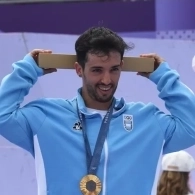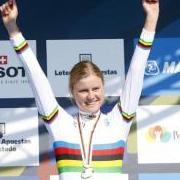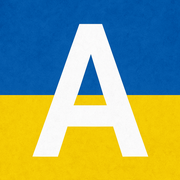-
Register/Login on Totallympics!
Sign up to Totallympics to get full access to our website.
Registration is free and allows you to participate in our community. You will then be able to reply to threads and access all pages.
If you encounter any issues in the registration process, please send us a message in the Contact Us page.
We are excited to see you on Totallympics, the home of Olympic Sports!
-
Posts
50,488 -
Joined
-
Last visited
-
Days Won
627
Reputation Activity
-
 heywoodu reacted to Noorderling29 in Cycling - Track Discussion | Qualification to Summer Olympic Games Los Angeles 2028
heywoodu reacted to Noorderling29 in Cycling - Track Discussion | Qualification to Summer Olympic Games Los Angeles 2028
Article on Ellis Ligtlee on the NOS site today. Her chemo therapy was succesfull. But further treatment next year, with radiation therapy and reconstruction operation. So, not out of the woods just yet.
-
 heywoodu got a reaction from konig in [OFF TOPIC] General Chat
heywoodu got a reaction from konig in [OFF TOPIC] General Chat
Yep, the amount of emergency services I heard at some point was a little extreme (for our little town), so I checked what was going on and saw they were all being called to a specific location. Until then I thought maybe it was part of a parade of trucks and agricultural vehicles that was on it's way from the next town over, decorated with lights and stuff.
Since I knew it was on the parade route, I was sure one of those big vehicles had hit people somehow (there were, besides the many vehicles, also two helicopters on the way, meaning it certainly wasn't about a single victim).
We picked our bikes and went to take a look, absolutely chaos in the area. Never saw so many services combined together, fire trucks from 20km away, ambulance after ambulance came racing by, people frantically trying to make way for them (the roads weren't really closed yet).
While there we heard someone who had been close say that the parade hadn't arrived yet and what seemed to have happened was that a car from the other side came onto the roundabout and simply never turned. "It's a massive drama over there, unbelievable", he said.
Quite quickly rumours started spreading of course, the first one turned out to be true: a middle aged (local) woman was behind the wheel and seems to have become unwell. Local security camera showed the car going at high speed right before the roundabout.
Plenty of rumours going around in terms of who were involved of course, and people keeping each other up to date to see if they know this or that family and such...
Never expected my little town to be big news in the Netherlands, even including some breaking broadcasts, live reporters and everything, damn. By far the biggest thing to happen here in my memory
-
 heywoodu got a reaction from hoversaBR in Russia-Ukraine Crisis Consequences in Sports
heywoodu got a reaction from hoversaBR in Russia-Ukraine Crisis Consequences in Sports
Of all the valid points one can make, I'd say someone's mastery of the English language shouldn't really be one on an international forum like this. I think at least 80% of us don't have English as native language, and there's logically going to be a difference in levels.
Again, not disagreeing with the actual contents of what you and people here are saying, but attacking one's language skills (other than an innocent joke here or there, for which this isn't exactly the right place of discussion I assume) feels unnecessary and kind of takes away from the actual content
-

-
 heywoodu got a reaction from phelps in Winter Olympic Games Milano Cortina 2026 News
heywoodu got a reaction from phelps in Winter Olympic Games Milano Cortina 2026 News
Yeah, there's certainly things to complain about from an athletes' perspective, but snow should really not be much of an issue indeed. Mostly things like the enormous geographical spread and it's consequences like there not being one big opening ceremony and everything being spread around a bunch of small Olympic 'villages'/accomodations - so not really the Olympic feeling and atmosphere for the athletes since they'll mostly just stay around athletes of their own sport as in any regular competition.
We'll be going very near to the Olympic area in a few weeks (Coppa Italia in Falcade), let's see what things look like by then.
-
 heywoodu got a reaction from MatiReimundo in [OFF TOPIC] General Chat
heywoodu got a reaction from MatiReimundo in [OFF TOPIC] General Chat
Yep, the amount of emergency services I heard at some point was a little extreme (for our little town), so I checked what was going on and saw they were all being called to a specific location. Until then I thought maybe it was part of a parade of trucks and agricultural vehicles that was on it's way from the next town over, decorated with lights and stuff.
Since I knew it was on the parade route, I was sure one of those big vehicles had hit people somehow (there were, besides the many vehicles, also two helicopters on the way, meaning it certainly wasn't about a single victim).
We picked our bikes and went to take a look, absolutely chaos in the area. Never saw so many services combined together, fire trucks from 20km away, ambulance after ambulance came racing by, people frantically trying to make way for them (the roads weren't really closed yet).
While there we heard someone who had been close say that the parade hadn't arrived yet and what seemed to have happened was that a car from the other side came onto the roundabout and simply never turned. "It's a massive drama over there, unbelievable", he said.
Quite quickly rumours started spreading of course, the first one turned out to be true: a middle aged (local) woman was behind the wheel and seems to have become unwell. Local security camera showed the car going at high speed right before the roundabout.
Plenty of rumours going around in terms of who were involved of course, and people keeping each other up to date to see if they know this or that family and such...
Never expected my little town to be big news in the Netherlands, even including some breaking broadcasts, live reporters and everything, damn. By far the biggest thing to happen here in my memory
-
 heywoodu got a reaction from hckošice in [OFF TOPIC] General Chat
heywoodu got a reaction from hckošice in [OFF TOPIC] General Chat
Yep, the amount of emergency services I heard at some point was a little extreme (for our little town), so I checked what was going on and saw they were all being called to a specific location. Until then I thought maybe it was part of a parade of trucks and agricultural vehicles that was on it's way from the next town over, decorated with lights and stuff.
Since I knew it was on the parade route, I was sure one of those big vehicles had hit people somehow (there were, besides the many vehicles, also two helicopters on the way, meaning it certainly wasn't about a single victim).
We picked our bikes and went to take a look, absolutely chaos in the area. Never saw so many services combined together, fire trucks from 20km away, ambulance after ambulance came racing by, people frantically trying to make way for them (the roads weren't really closed yet).
While there we heard someone who had been close say that the parade hadn't arrived yet and what seemed to have happened was that a car from the other side came onto the roundabout and simply never turned. "It's a massive drama over there, unbelievable", he said.
Quite quickly rumours started spreading of course, the first one turned out to be true: a middle aged (local) woman was behind the wheel and seems to have become unwell. Local security camera showed the car going at high speed right before the roundabout.
Plenty of rumours going around in terms of who were involved of course, and people keeping each other up to date to see if they know this or that family and such...
Never expected my little town to be big news in the Netherlands, even including some breaking broadcasts, live reporters and everything, damn. By far the biggest thing to happen here in my memory
-
 heywoodu got a reaction from Quasit in [OFF TOPIC] General Chat
heywoodu got a reaction from Quasit in [OFF TOPIC] General Chat
Yep, the amount of emergency services I heard at some point was a little extreme (for our little town), so I checked what was going on and saw they were all being called to a specific location. Until then I thought maybe it was part of a parade of trucks and agricultural vehicles that was on it's way from the next town over, decorated with lights and stuff.
Since I knew it was on the parade route, I was sure one of those big vehicles had hit people somehow (there were, besides the many vehicles, also two helicopters on the way, meaning it certainly wasn't about a single victim).
We picked our bikes and went to take a look, absolutely chaos in the area. Never saw so many services combined together, fire trucks from 20km away, ambulance after ambulance came racing by, people frantically trying to make way for them (the roads weren't really closed yet).
While there we heard someone who had been close say that the parade hadn't arrived yet and what seemed to have happened was that a car from the other side came onto the roundabout and simply never turned. "It's a massive drama over there, unbelievable", he said.
Quite quickly rumours started spreading of course, the first one turned out to be true: a middle aged (local) woman was behind the wheel and seems to have become unwell. Local security camera showed the car going at high speed right before the roundabout.
Plenty of rumours going around in terms of who were involved of course, and people keeping each other up to date to see if they know this or that family and such...
Never expected my little town to be big news in the Netherlands, even including some breaking broadcasts, live reporters and everything, damn. By far the biggest thing to happen here in my memory
-
 heywoodu got a reaction from phelps in Injured athletes who will miss Winter Olympic Games Milano Cortina 2026
heywoodu got a reaction from phelps in Injured athletes who will miss Winter Olympic Games Milano Cortina 2026
Hamar isn't exactly fast neither
Like I said, that's fine though. It would be great to have Olympics on a relatively slow track, which makes for different kind of races but certainly no less interesting.
-
 heywoodu reacted to OlympicIRL in Totallympics Annual International Song Contest 2025
heywoodu reacted to OlympicIRL in Totallympics Annual International Song Contest 2025
I have scheduled the voting order draw for later today. I will be using a random generator to auto-generate the results. If anyone is interested, I have posted a ticket of the scheduled draw. There is no result available yet but will appear once the draw has passed the scheduled time.
https://www.randomresult.com/ticket.php?t=4047191GXV9CAS4M2
-
 heywoodu got a reaction from Agger in Winter Olympic Games Milano Cortina 2026 Tickets, Trips and Experiences
heywoodu got a reaction from Agger in Winter Olympic Games Milano Cortina 2026 Tickets, Trips and Experiences
Who knows, maybe see you there
I know I also have biathlon tickets but I have no idea which ones exactly, need to start putting things together. I know the women's sprint is among them so, if plans work out well, Bruna and I and my family (and her employees) all come and cheer for Baiba Bendika
-
 heywoodu got a reaction from hckošice in Totallympics Suggestions and Problems Thread
heywoodu got a reaction from hckošice in Totallympics Suggestions and Problems Thread
Please do not bring this idea to Sindo
-
 heywoodu got a reaction from ChandlerMne in Totallympics Suggestions and Problems Thread
heywoodu got a reaction from ChandlerMne in Totallympics Suggestions and Problems Thread
Please do not bring this idea to Sindo
-
 heywoodu got a reaction from Sindo in Totallympics Suggestions and Problems Thread
heywoodu got a reaction from Sindo in Totallympics Suggestions and Problems Thread
Please do not bring this idea to Sindo
-
 heywoodu reacted to hckošice in Totallympics Suggestions and Problems Thread
heywoodu reacted to hckošice in Totallympics Suggestions and Problems Thread
My first bulbes destroying in one move of the year done. needed only 4 attempts
-
 heywoodu reacted to ChandlerMne in Totallympics Suggestions and Problems Thread
heywoodu reacted to ChandlerMne in Totallympics Suggestions and Problems Thread
Pitty that bulbs dont appear on Android.
-
 heywoodu reacted to OlympicIRL in Totallympics Annual International Song Contest 2025
heywoodu reacted to OlympicIRL in Totallympics Annual International Song Contest 2025
has just delivered their votes which means that all nations have now voted and we have no disqualifications this year
The voting window will officially end tomorrow (Friday) at midnight GMT after which I will post details about the voting order draw. It’s likely going to be a random draw from a random generator site to save time in this busy period. I will schedule the draw and post a ticket so users can view the result after the scheduled time. More to come on that on Saturday.
Thanks again to all participants
-
 heywoodu got a reaction from Josh in Cross-Country Skiing Discussion | Qualification to Winter Olympic Games Milano Cortina 2026
heywoodu got a reaction from Josh in Cross-Country Skiing Discussion | Qualification to Winter Olympic Games Milano Cortina 2026
For a 3rd ticket for Brazil, which would make her/our life a significant amount easier, yes
Whether or not she actually needs it will depend a lot on Jaqueline Mourao making or not making the A criterium (under 150.00 FIS distance points on 18/19 January).
Last time Brazil was 1 position too low to get a 3rd ticket, but I think this time more countries got the basic quota and so fewer tickets are available for the next steps in the allocation system. Which is an even bigger deal in the men's situation, where I believe it looks like not a single nation will even get to the maximum of 8 spots.
-
 heywoodu reacted to intoronto in Cross-Country Skiing Discussion | Qualification to Winter Olympic Games Milano Cortina 2026
heywoodu reacted to intoronto in Cross-Country Skiing Discussion | Qualification to Winter Olympic Games Milano Cortina 2026
Serbia's Olympic Committee rejected its quota for 2022 and Liechtenstein is a maybe. They have rejected quotas in the past.
-
 heywoodu got a reaction from avlar in Cross-Country Skiing Discussion | Qualification to Winter Olympic Games Milano Cortina 2026
heywoodu got a reaction from avlar in Cross-Country Skiing Discussion | Qualification to Winter Olympic Games Milano Cortina 2026
The FIS qualification table is quite slow to be updated, also after Israel's man qualified it took a little bit of time. She certainly got it without problems, so they should be added soon.
-
 heywoodu got a reaction from OlympicIRL in Totallympics Annual International Song Contest 2025
heywoodu got a reaction from OlympicIRL in Totallympics Annual International Song Contest 2025
Just to update: I've certainly listened to everything more than once, just need to find a moment to rank them, but that should be fine
-
 heywoodu got a reaction from mrv86 in Winter Olympic Games Milano Cortina 2026 Opening Ceremony Flag Bearers
heywoodu got a reaction from mrv86 in Winter Olympic Games Milano Cortina 2026 Opening Ceremony Flag Bearers
I hope not, because what I'm hoping for is that the person I'm cooking dinner for at this moment will carry the flag, but yeah, Braathen exists so that's unlikely
One of my favorite Totallympics threads though anyway, always fun to see who is chosen
-
 heywoodu got a reaction from mrv86 in Winter Olympic Games Milano Cortina 2026 Opening Ceremony Flag Bearers
heywoodu got a reaction from mrv86 in Winter Olympic Games Milano Cortina 2026 Opening Ceremony Flag Bearers
Where can I bet my mortgage, parents and intellectual property rights to anything I might ever invent (unlikely as that is to ever be relevant) on Lucas Braathen carrying Brazil's flag in the opening ceremony and Nicole Silveira carrying it in the closing ceremony? (snow federation chooses for opening, ice federation chooses for closing in Brazil)
-
 heywoodu reacted to hckošice in Floorball Discussion Thread
heywoodu reacted to hckošice in Floorball Discussion Thread
Play-off round fixtures:
Quarterfinals
vs /
vs /
vs / @heywoodu
vs /
13th-16th Place Semifinals
-
-
-
 heywoodu reacted to Grassmarket in Cross-Country Skiing FIS World Cup 2025 - 2026
heywoodu reacted to Grassmarket in Cross-Country Skiing FIS World Cup 2025 - 2026
And remember the Olympic Paradox - it is slightly easier to get a medal at the Olympics than at a World Cup because in the Olympics the numbers of racers from the powerful nations are capped at 4.
-
Who's Online 6 Members, 0 Anonymous, 345 Guests (See full list)



.jpg.e5b0840ef563cae48b46dc0f10a604a7.thumb.jpg.92e5e8dbc7e0d559b26d53b50a12f0b2.jpg)








